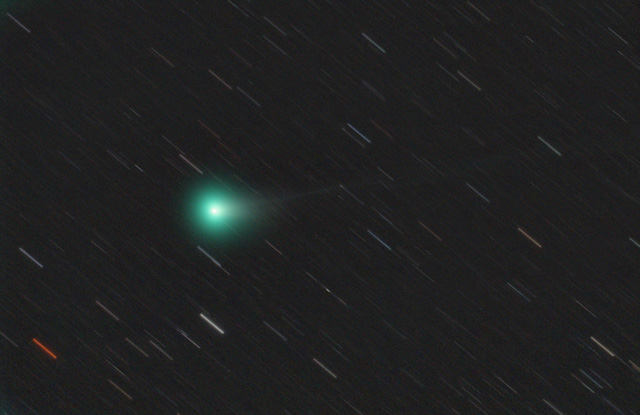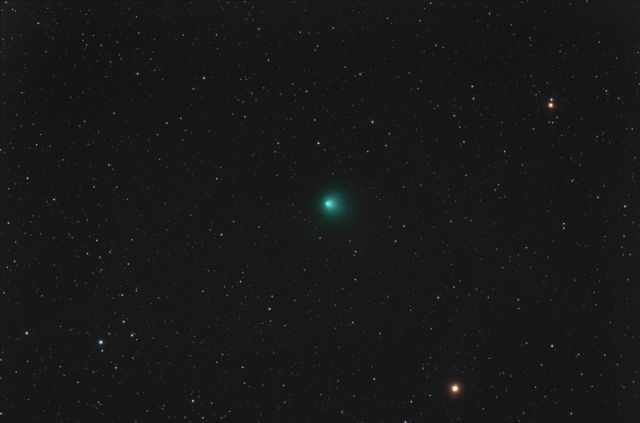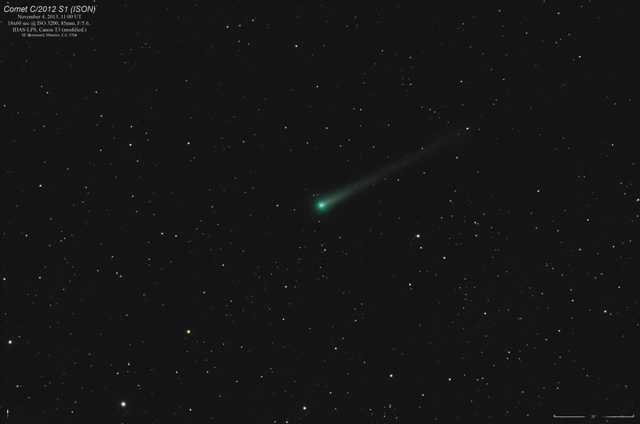

| Visitors Now: | |
| Total Visits: | |
| Total Stories: |
Biggest and Brightest Comet in Sky Right Now is Not ISON!
Yes, you heard me. The biggest and brightest comet in the sky as of November 10, 2013 is not Comet ISON, even though ISON is getting the most hype. It is another comet that is outclassing ISON as far as brightness and tail length. It is called Comet Lovejoy (C/2013 R1) and is currently sporting a tail that is over 3 degrees (six moon diameters) in length. ISON is, at the moment, about 1 degree in size.
 Comet Lovejoy on November 8, 2013.
Comet Lovejoy on November 8, 2013.
Comet Lovejoy was discovered in September of this year by Terry Lovejoy of Austrailia and was his fourth. A previous comet he discovered was a sun-grazer much like Comet ISON and it developed a huge tail after perihelion with the Sun in 2011. In fact, a lot of the hype for ISON is based on that comet and how it played out.

Comet Lovejoy movement in 1 Hour of exposure on Nov 8th. Note the tail extends out the frame to the right.
In addition to Comet Lovejoy and ISON, we still have the relatively bright comets Encke and LINEAR in the sky as well as a faint comet in Pegasus called Brewington. Still fainter are dozens other comets that you will never hear about since they are only visible in very large telescopes or through photographic means.
 Comet Encke on October 8th, 2013
Comet Encke on October 8th, 2013
Comet Lovejoy is currently well placed in the sky is is nearly overhead at dawn. Comet ISON on the other hand is diving towards the east-southeast horizon and is getting lower and lower in the sky at the start of twilight, which means it is harder to see and photograph. Soon, the moon’s brightness plus ISON’s low altitude will hinder observations as it gets closer to its November 28, 2013 perihelion date.
 Comet ISON on November 4th, 2013
Comet ISON on November 4th, 2013
C/2013 R1 (Lovejoy) will continue to be seen in November and is closest to the Earth on November 23 while the comet is near the Big Dipper. The Moon will hamper observations, however. So, the time to catch Comet Lovejoy (and Comet ISON) is before the moon dominates the morning skies, which will be about November 15, 2013 and onwards until new moon. The new moon is in early December and further unhindered observations of these morning comets will be able to continue at that time.





What do you believe is in the night sky when you look West in the United States.. The object gets brighter every month , I looked through my telescope (cheap one ) and it looks like a planet,, Ive checked where Venus should be , its not Venus , its not Jupiter, its not Saturn , I see them all in my telescope …. so all you brains out there …. what is it ? People are talking about it all over the internet, but, no one seems to have a factual answer !
The brightest “star” in the west after sunset is the planet Venus at the moment. So, if you see two bright objects in the west then one of them is definitely not Venus. However, if you are seeing only one bright object, I assure you it is Venus and it is right where it is supposed to be.
say hello to my little friends
http://www.youtube.com/watch?v=2JQCkojp3fM